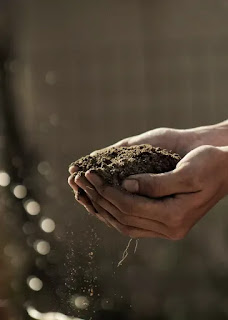Soil :
A mixture of organic matter, minerals, etc
Soil is the soft and granular covering of the earth's surface. Soil is formed by mixing minerals and organic compounds formed by crushing rocks.
In the presence of organic matter, soil erosion has taken place from rocks through natural and chemical changes such as soil erosion, erosion, etc.
That is why very ancient soil is not found in the world. Soil is formed from rocks through the interaction of topography, water, air and biomass.
Russian scientist Dokuchaev is said to be the father of soil science. He gave ideas about soil
" Soils are applied solely to those superficial or nearly superficial horizons of rocks, that have been more or less modified naturally by the interaction of water, air and various kinds of organisms, either living or dead; this being reflected in a certain manner in the composition, structure and color of such formations. Where these conditions are absent, there are no natural soils, but artificial mixtures of rock. "
- Dokuchaev (1879).
In addition to the scientist Dokuchaev, many other scientists have define the soil in different ways. But among them, the best idea about the soil is found from the scientist Kellogg.
According to the scientist Kellogg :
" Soil is a collection of natural bodies occupying a portion of the earth surface that supports plant growth and that has properties due to the integrated effect of climate and vegetation acting upon parent material, as conditioned by relief, over a period of time."
Kellogg(1960)।
Here are five factors that contribute to soil formation.
These are 1. Parent material
2. Climate
3. Biota
4. Topography
5. Time
Time it is not possible to form soil without any one of these five.
The soil contains a mixture of minerals and organic matter. Its constituents exist in the soil in solid, liquid, and gaseous conditions. The soil particles are loosely attached, so that there is ample space for air and water circulation.
Soil density in most areas is 1 to 2 g / cm3. Most of the Earth's surface is formed after the Tertiary period. Elsewhere, there are no Pleistocene soils.
Quality of soil :
Soil is a mixture of soft minerals and organic matter on the surface of the earth which acts as a natural medium for plant growth. Soil is mainly composed of 4 main elements. These are mentioned below:
Minerals - 45%
Organic matter - 5%
Wind - 25%
Water - 25%
Minerals:
The mineral crust was first formed by rocks. It is later broken down into small pieces or units in the process of rock erosion. This part of the soil is made up of sand, silt and clay particles.
The process of rock erosion releases the above particles and essential nutrients such as nitrogen, phosphorus, potassium, calcium and other nutrients into the soil. The mineral content of the soil is 45%.
Organic matter :
Soil contain 1-2% organic matter but frozen soils contain 2-5% organic matter. All these organic substances come to the soil from the remains and excrement of plants and animals.
Organic matter is used as soil binding material. Although the amount of organic matter in the soil is very low, it greatly controls the quality of the soil.
Organic matter plays the following important role-
(I) Acts as a warehouse for all nutrients;
(II) Improves the physical, chemical and biological properties of the soil;
(III) Prevents soil erosion;
(IV) Having extra respiratory organs, these fish can survive by taking oxygen from the air;
(V) The result can be marketed alive;
(VI) Increases water holding capacity;
(VII) The main energy of microorganisms is this organic matter and Organic matter is the main source of nitrogen in the soil.
Air and water :
When air and water are used during heavy rains or irrigation, most of the soil pores are filled with water.
But during dry or drought those pores are filled with air. Soil air contains more carbon dioxide and water vapor than atmospheric air but contains less oxygen.
The main function of air is to participate in the process of respiration. The important functions of air and water are-
(I) Controlling the physical, chemical and biological functions of the soil;
(II) Assist in the process of rock erosion;
(III) Participate in photosynthesis methods and
(IV) Acting as solvent and carrier of nutrients.
Soil types :
Soil textures are named based on the comparative proportions of these three distinct soil particles - sand, silt and mud. Different soils contain different proportions of sand, silt and mud particles. Some soils have more sand particles, while others have more clay particles.
Within the boundaries of this change, the soil is divided into 12 groups. These groups are known as text-based classes. Significant differences in the physical, chemical and biological properties of one of these classes are observed.
Soil that has more clay particles is called clay soil, soil which has more sediment particles is called silt soil, and soil which has more sand particles is called sand soil.
If a soil does not exhibit any of the physical properties affecting any of these three classes (e.g. -40% sand particles, 20% clay particles and 40% sedimentary soils), it is called loamy soil.
The percentage of sand, silt and clay particles in loamy soils is not the same. But it exhibits almost consistent properties or properties near sand, silt and clay particles.
Physical-chemical properties of soil :
The chemical properties of the soil or STH are a set of characteristics, dependent on chemical or physical-chemical phenomena, in close relationship with the climate and above all living organisms, which contribute to defining one of the aspects of soil fertility, influencing the potential production of cultivated plants.
pH :
Soil pH is a measure of soil acidity. In case of soil science pH define as the negetive logarithm of hydrogen ion (H+) activity.
Usually the pH value falls between 3 and 10 or 7 is neutral.
Acid soils have a pH below 8 and alkaline soils have a pH above 6. Ultra-acidic soils (pH <3.5) and very strongly alkaline soils (pH> 9) are rare.
Soil pH is considered variable in the soil. This is because it affects many chemical processes. It regulates the chemical forms of various nutrients and affects the chemical reactions they undergo. Specially affects plant nutrient availability. The optimum pH range for most plants is between 5.5 and 7.5. However, many plants can adapt to pH when combined. Even if the values are outside the range of 5.5 or 6.5.
The U.S. Department of Agriculture's Natural Resources Conservation Service classifies soil pH ranges as follows:
Ultra acidic <3.5
Extremely acidic 3.5 -4.4
Very strong acid 4.4-5.0
Strong acid 5.1-5.5
Medium acid 5.6-6.0
Slightly acidic 7.1-6.5
Neutral 7.6-6.3
Slightly alkaline 6.4-6.6
Moderately alkaline 7.9-6.4
Strongly alkaline 7.5-9.0
Very strongly alkaline> 9.0






0 Comments
Please do not enter any spam link on the comment box